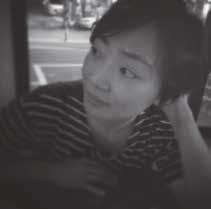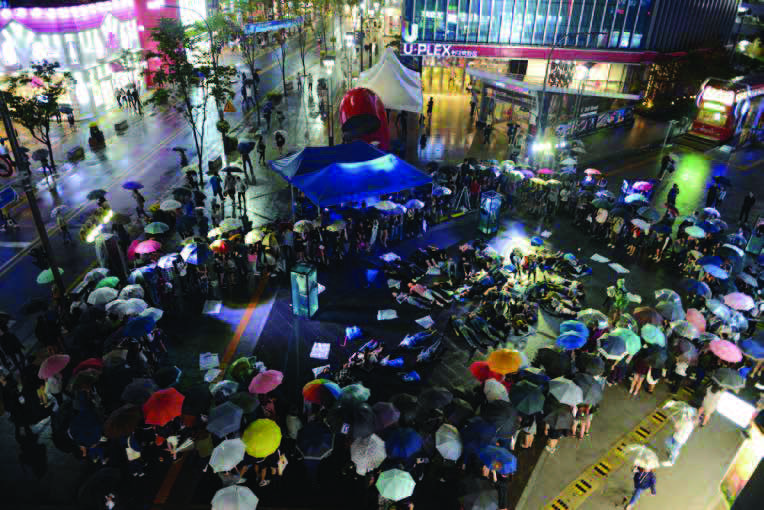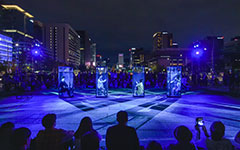Performance Info
LEE Jin Yeob (Charlye) (Theatre director. Director of the theatre company Elephants Laugh )
: Homo Ludens – the restoration of hidden senses
What made you involved in performance?
I majored in fine art in university and went to study in England. My major at Nottingham Trent University was stage design, but I was more fascinated by creating performance. My main fields of study were site-specific performance, environmental theatre and happening. I came back to Korea in 2007 after completing my master’s course.
Upon returning, I joined the Homo Ludens Company led by director NAM Geung Ho and I took charge of stage design. We showcased The day like today (co-constructed by LEE Jin Yeob and NAM Geung Ho, directed by NAM Geung Ho), a 58-hour-long performance without pause at Jongmyo Shrine, Seoul. Then I founded the theatre company Elephants Laugh in 2009.
You have focused on site-specific performances and community art projects. And these projects started in Ibjeong-dong, Cheonggyecheon.
After the inception of Elephants Laugh, the site of the first project was Ibjeong-dong. When I visited the site, I came to decide to present a performance right there on the spot because a worker I met there said he had never seen a performance.
Handcraft technicians in Ibjeong-dong participated in our performances, including WIND, HOPE (2009), winter movement (2011), Neighborhood Museum #1 Chunggye (2012), Neighborhood Museum #3 Ju Story (2013) and SPRING, WIND (2016). The performances were like a community festival. Neighborhood Museum #2 Wongokdong (2012) and Ddinga! Ddinga! in Plaza (2012) performed in Wongok-dong, Ansan and Art Peddler Projent #1 Ansan Simin Market (2013) presented at Ansan citizenry market in Choji-dong were similar. Workers working in these hidden places of the city seemed to be hidden people. Therefore, I wanted to show their life stories to the audience so that they can communicate with each other.
The process of this work was very tough but the way of working was quite simple. Artists visit the community, teach the residents arts and learn the skills of life from them in return. As a result, a work is created based on the language they learned from and shared with each other. The outcomes of our work looked like an exhibition sometimes or a performance sometimes. These works were presented in the form of a festival and visitors from different areas came and watched them. Visitors were also invited to participate on the spot.
There are both specific and unspecific audiences who are invited to the work. And they blend together. Finally, they are tied together by volunteer participation.
I tend to pay attention to those who are not as sensitive as artists. So my goal was to create an environment in which those who are excluded from art or play, or those who are sensitive become the main performers and play altogether.
A manual to play (2013) is a combination of clown play and audience participation. A clown first shows how to perform the old-time plays and the audience then copy him. It invites audiences to move and participate through the collective experience of performance so that they exchange energy with performers. It is intended for contemporary who live a monotonous and repetitive routine of life and probably need an experience of ’play together.’
Your recent works seem to awaken participants’ senses. We come to reflect on the senses of our own body, while eliminating certain senses or awakening consciousness.
Nothing To See Here (2015) is a project demonstrating everyday life of the visually handicapped. There is a national school for the blind in my neighborhood and I was curious how the handicapped feel about the space as I often see them around. So I held a workshop to learn about their routine of life and the whole process was presented as exhibitions and performance tours. During the course of the project, I felt that art is not much different from society. Although we talk about art for all, I fully realized that ’the handicapped’ are not included to this ’all’ that art says.
In Bodies in the Dark (2015), participants are asked to take off their clothes one by one and their bodies come in contact with the others’ bodies in an invisible dark space. In this project, I wanted to make an attempt against the tendency that our thought is controlled by society and education. What I intended was to make audiences experience self-censorship, a societal perspective, an animal instinct, shame and ethical standards by themselves in the darkness. But with their active volunteer participation, I had to change the content and format of the performance.
When you conceive a work, what do you do to express spectatorship and placeness?
I’m usually inspired by everyday life and objects around me and discover topics from the things I’ve been interested in. In choosing the form of work, it is important to see how audiences can experience these topics. What I direct is not a mise-en-scène of the work, but the environment making audience participation possible. I also ask performers to lead the performance in a natural manner in order to induce audience participation, rather than do acting. Maybe for this reason, every performance shows a kind of variation in its form. As part of maximizing volunteer participation of audience, I am conceiving a work with no performers these days. In my work, the roles of audiences gradually increase, whereas those of performers decrease.
It is the same with space. Ordinary places give me more inspiration. In fact, I’ve never presented a work in a theatre. Such a space feels like a dead space to me. Alternative space is the same, too. It is an even more standardized platform. I prefer a space that I find, intervene in and bring to life. For example, 201, there is Einstein (2014), I set the house where I live as an imaginary space. In each performance, about 5 people visited my house and went on an adventure all over the rooms.
MULZIL focuses on the space of city. Audiences move around the urban space and participate in the work as performers.
This work consisting of a series of images without narrative structure sees the city from an objective standpoint. The starting point of the work is to notice that ’we’ are part of the scenery of the city, seen from Nodeul Island of the Han River. Then it moves into the central space of the city. The images of sculptures instead of one’s own images represent the people living in the city in an abstract manner. People on the street see these images and they become the mirror to each other. It requires a concept of audience design handling the eyes of participants and spectators.
’Mulzil‘ refers to underwater work by haenyeo(female divers). The haenyeo who work on the verge of death reminded me of contemporary people. So I thought our life in the city is not different from haenyeo’s ’mulzil’. As the haenyeo feel the four seasons in the sea, we also feel our ordinary life in the city. That is why I attempted an exchange of urban environment for underwater environment.
You have some overseas experience. How were your performances in foreign countries?
Nothing to See Here was created in collaboration with the Australian artist Nathan Stoneham. The works he participated in were brought to Korea to help understand the characteristics of each other’s work and we worked on this project together over a long period of time.
After meeting Macau audiences with Nothing to See Here and Bodies in the Dark, I became more curious and willing to see audiences in different countries. With ’Elephants Laugh’, I felt that the atmosphere and interpretation of performance can vary depending on the environment of performance and audience. Foreign audiences were quite different from Korean audiences. I also have a different perspective on my performance now. Performances in foreign countries helped me find another possibility. I’d like to have more experience of working abroad.
Production Details
- Director
LEE Jin Yeob (Charlye)
Reference
- E-mailcharlye337@hotmail.com












 PREV
PREV
.jpeg)
.jpg)
_(c)포스(FORCE).jpg)
_(c)장석현_코끼리들이 웃는다(SUKHYUN JANG_ELEPHANTS LAUGH).jpg)
.jpg)
.jpg)
_(c)한받(Hahn Vad).jpg)
_(c)비주얼씨어터 꽃(CCOT)(1).jpg)
_(c)봉앤줄 (BONGnJOULE)(1).jpg)
_(c)대한민국연극제 2019 (Korea Theater Festival 2019)(0).jpg)
_(c)몸꼴(Momggol)(1).jpg)
.png)
2018MODAFE_Taemin Cho (2).jpg)










